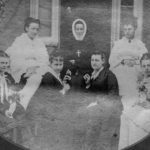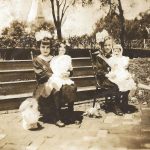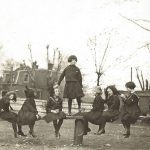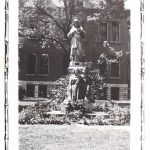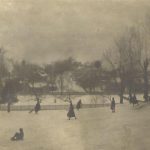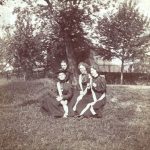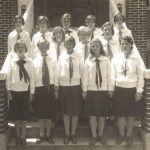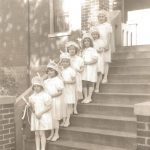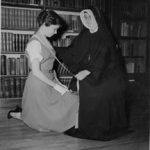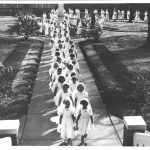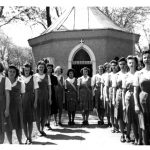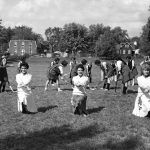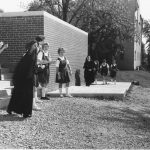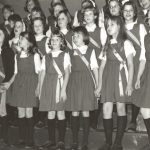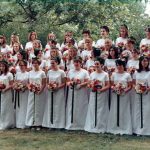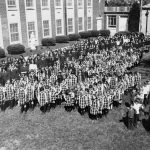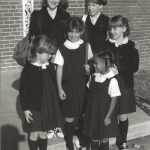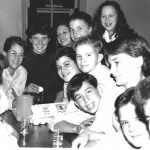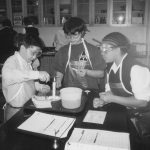In 1818, at age 48, Philippine Duchesne set out with four other Sacred Heart nuns on a voyage across the Atlantic Ocean and upriver from New Orleans to the tiny village of St. Charles on the Missouri River, 25 miles from St. Louis. There, in a primitive log cabin, Mother Duchesne opened the Academy of the Sacred Heart—the first free school west of the Mississippi, and the first of many Schools of the Sacred Heart in the United States. To learn more, visit First Sacred Heart School in America.
The following video is an excerpt of HEC-TV’s A Mission to Educate, about the history of Catholic education in the Archdiocese of St. Louis. This excerpt describes the Academy’s founding by Philippine Duchesne in 1818.
The Academy Timeline
IMPORTANT DATES IN ACADEMY HISTORY
1800
Madeleine Sophie Barat founded the Society of the Sacred Heart; the following year its first foundation was made in Amiens, France.
1804
Philippine Duchesne joined the fledgling Society of the Sacred Heart.
1818
At the invitation of Bishop DuBourg, Philippine Duchesne traveled to the New World to establish the first Sacred Heart School in America. The Academy of the Sacred Heart in St. Charles was the first free school west of the Mississippi.
1819
Financial difficulties and the lack of boarding students caused the Academy to relocate to Florissant, Missouri.
1821
St. Charles became the First Capital when Missouri was admitted to the Union.
1828
The Jesuits drew the Society of the Sacred Heart back to its cradle foundation in St. Charles. They had just built the large stone church dedicated to St. Charles Borromeo.
1835
The Society committed to a permanent establishment in St. Charles by erecting the first brick convent and school.
1840
Section of brick building just north of 1835 (original) building was added.
1841
Philippine Duchesne traveled to Sugar Creek, Kansas and spent a year with the Potawatomi Indians, realizing a lifelong dream of working with Native Americans. They called her “the woman who prays always.”
1852
At age 83, Philippine Duchesne died in St. Charles, where she lived the last ten years of her life.
1856
Section of brick building just south of 1835 building (now the Conference Room) was added.
1858
A brick parish school was built on the campus near Second Street; RSCJ taught the town children there. It ceased to function in the 1890s.
1860
Primary Wing was added to west side of building.
1865
During Civil War soldiers were encamped in tents on Academy grounds. Troops drilled and property was protected and thoroughly respected.
1883
Chapel (now Cribbin Hall) was built on north end of campus.
1886
Science Wing was added on south end of building.
1893
A brick building near the Decatur gate was built. Originally planned to be a parish school, it became instead the laundry. Almost 100 years later, it became the home of the Philippine Community.
1905
The “tower” was added to the Primary Wing.
1940
Pope Pius XII beatified Philippine Duchesne.
1951
Under the patronage of Archbishop Ritter, ground was broken for the Shrine of St. Philippine Duchesne; the freestanding building was completed one year later.
1952
Shrine was completed partially, awaiting additional funds for final nave to the south.
1961
The south wing of the school was added, connecting the Academy and the Shrine.
1966
Shrine was finished (without nave) in contemporary liturgical design.
1967
Regis Hall was built to house primary classes and residence for boarders. This building was almost exactly placed on the original Duquette Mansion (log cabin of the school’s 1818 beginning).
1972
The high school was closed. The last class of high school seniors graduated in the spring. In the fall, boys were admitted for the first time in the grade school. Beginning as a co-institutional system, the girls’ school retained the title, Academy of the Sacred Heart. The boys’ school was called Perier Elementary (after the cousins of Philippine Duchesne, with whom she grew up and who were very generous to her in her missionary activities). That first year there were two classes of boys: primary and first grade. Each year another class was added until boys comprised all nine grades.
1980
The north wing was added and the old chapel became Cribbin Hall Library.
1986
Pre-Primary classes for 4-year-olds were begun.
1987
Rauch Memorial (gymnasium) was built and the existing gym became the school cafeteria (White Center).
1988
St. Philippine Duchesne was canonized by Pope John Paul II.
1993
With no clear division between boys’ and girls’ classes, the name Perier Elementary was discontinued.
2006
With educational research pointing the way, the school returned to its single gender roots. The seventh and eighth grades were divided into all-boys’ and all-girls’ classes. Pre-Primary through Sixth Classes remained coeducational.
2011
Single gender classes were extended to the sixth grade.
2017
Little Acorns, a half-day program for 3-year-olds, begins.
Over the past two centuries, the Society of the Sacred Heart has established hundreds of schools throughout the world, spreading its philosophy of educating the whole child and making God’s love known to the world. Today, this congregation of Catholic women has more than 2,000 members in provinces in 41 countries.
Here are the stories of three “founding mothers” of the Society.
St. Madeleine Sophie Barat
FOUNDRESS OF THE SOCIETY OF THE SACRED HEART
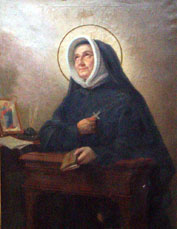 Madeleine Sophie Barat grew up in Joigny, France with the unusual advantage of a formal education provided by her brother Louis, a seminarian. At 15 she moved to Paris and met his friend, Father Joseph Varin, who became her mentor and spiritual advisor. On Nov. 21, 1800 Father Varin presided over the consecration of 20-year-old Sophie’s and her three companions’ lives to the service of God. Mother Barat used her prodigious gifts to spread the Society of the Sacred Heart across Europe, opening more than 80 houses where education was offered to young ladies. Her lifelong concern for the poor moved her to ignite that selfless spirit in her sisters and the children they taught. The commissioning to America of her dear friend and confidant, Philippine Duchesne, signaled the beginning of the missionary activity that would spread the order’s mission around the globe. The work of today’s Religious of the Sacred Heart is secured by the timeless principles that its foundress provided during her long lifetime. Madeleine Sophie Barat died in 1865, 13 years after the death of Philippine Duchesne. She was canonized in 1925.
Madeleine Sophie Barat grew up in Joigny, France with the unusual advantage of a formal education provided by her brother Louis, a seminarian. At 15 she moved to Paris and met his friend, Father Joseph Varin, who became her mentor and spiritual advisor. On Nov. 21, 1800 Father Varin presided over the consecration of 20-year-old Sophie’s and her three companions’ lives to the service of God. Mother Barat used her prodigious gifts to spread the Society of the Sacred Heart across Europe, opening more than 80 houses where education was offered to young ladies. Her lifelong concern for the poor moved her to ignite that selfless spirit in her sisters and the children they taught. The commissioning to America of her dear friend and confidant, Philippine Duchesne, signaled the beginning of the missionary activity that would spread the order’s mission around the globe. The work of today’s Religious of the Sacred Heart is secured by the timeless principles that its foundress provided during her long lifetime. Madeleine Sophie Barat died in 1865, 13 years after the death of Philippine Duchesne. She was canonized in 1925.
St. Rose Philippine Duchesne
FOUNDRESS OF THE ACADEMY OF THE SACRED HEART
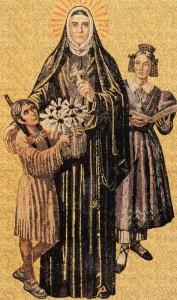
Rose Philippine Duchesne dreamed of coming to the New World to teach Indians. Born in Grenoble, France, in 1769, her desire to enter religious life was cut short by the French Revolution, during which she ministered to the poor and dying. After the war she met Madeleine Sophie Barat and, at age 35, joined a new congregation of religious women dedicated to teaching young girls. When Bishop William DuBourg visted the Paris convent in 1817, seeking teachers for his expansive American diocese, Philippine implored Mother Barat to allow her to go. The following year she and four religious companions made the arduous 70-day voyage across the Atlantic to New Orleans, traveled by steamship upriver to St. Louis, and ended in a log cabin in St. Charles—site of the first free school west of the Mississippi.
That difficult first year in the “Duquette Mansion” was followed by a more successful venture in Florissant and, later, a novitiate and other schools in Missouri and Louisiana. At age 72 she was finally allowed to travel to Kansas, where her deep devotion prompted the Potawatomi to call her Quakahkanumad (woman who prays always). Philippine Duchesne spent the last ten years of her life at the Academy in St. Charles, where she died on Nov. 18, 1852. She was canonized by Pope John Paul II in 1988. It is our great honor that our school was her first in this country and that her holy remains are enshrined here.
Photos of the Philippine Stained Glass Windows in Cribbin Hall by John Storjohann.
Janet Erskine Stuart
RENOWNED SACRED HEART EDUCATOR
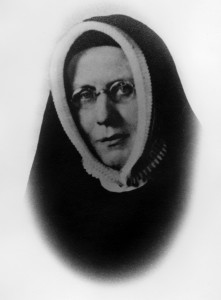 Janet Erskine Stuart was a woman of great compassion, judgment and intellect. The youngest daughter of an Anglican rector and mother who died when Janet was 14 months old, she, Janet converted to Catholicism at age 22 and entered the Society of the Sacred Heart three years later. She proved a natural and accomplished teacher, outlining her educational philosophy in The Education of Catholic Girls. She believed that “it is not so much what we say or do that educates; what really educates is who we are.”
Janet Erskine Stuart was a woman of great compassion, judgment and intellect. The youngest daughter of an Anglican rector and mother who died when Janet was 14 months old, she, Janet converted to Catholicism at age 22 and entered the Society of the Sacred Heart three years later. She proved a natural and accomplished teacher, outlining her educational philosophy in The Education of Catholic Girls. She believed that “it is not so much what we say or do that educates; what really educates is who we are.”
As Superior of the English houses, Mother Stuart traveled to Paris, to Rome and to the Society’s first school in St. Charles, from where she wrote: ”[Philippine Duchesne’s] presence seems to be constantly here with one, even in the chapel which she never saw, but especially in the old house, and above all in the little cell where she died.” Mother Stuart was elected the sixth Superior General of the Society but died three years later, in 1914. She remains a preeminent figure within the Society of the Sacred Heart.
Customs, traditions, and feast days that make up our “Life at the Sacred Heart”
FIRST FRIDAY
The Society of the Sacred Heart is consecrated to the Heart of Jesus; therefore, giving special love to Our Lord on the First Friday of every month has always been a devotion close to the hearts of Religious and children of the Sacred Heart. All come together to celebrate the liturgy and to express love of Jesus and love for each other. In addition, Eucharistic Adoration takes place in the Shrine.
MASS OF THE HOLY SPIRIT
During the first weeks of school, the Mass of the Holy Spirit is celebrated as a formal opening of the school year. At this liturgy all the activities of the year are offered to God, and the children ask Him to bless their work and keep them close to Him.
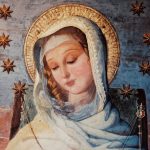 FEAST OF MATER ADMIRABILIS
FEAST OF MATER ADMIRABILIS
This feast of our Blessed Mother is especially dear to Sacred Heart children. Mater Admirabilis is the name given to the statue of Our Lady which you will find in a place of honor in every Sacred Heart school. “Mater Admirabilis” is Latin, meaning “Mother Most Admirable.” This feast is celebrated on October 20. As on other solemn feast days, both girls and boys wear dress uniforms. A liturgy is celebrated, and the story of this beautiful picture is retold in many ways.
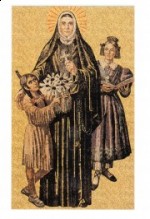 FEAST OF SAINT PHILIPPINE DUCHESNE
FEAST OF SAINT PHILIPPINE DUCHESNE
St. Philippine Duchesne founded the Academy—the first Sacred Heart school in North America —in 1818. Her feast is celebrated on November 18, the date on which she died. She is honored for her saintly and courageous life on the American frontier. The children at St. Charles are especially proud of the close ties to Mother Duchesne. Her feast day denotes one of the most special celebrations of the year.
FEAST OF THE IMMACULATE CONCEPTION
Traditionally, Children of the Sacred Heart, carrying lilies and candles, have honored Mary on this feast with a procession and a prayer of dedication said by children all over the world throughout many generations: “O Mary, I give you the lily of my heart. Be its guardian forever.”
CHRISTMAS BASKET LITURGY
This event occurs on the last day before the Christmas holidays, and participation is considered both an honor and a responsibility. A special liturgy highlights the value of personal sacrifice in order to bring Christ’s joy to others, as each family provides a basket of food to be given to those in need.
CONGÉ
A Congé is a “play day” at school. It comes when least expected! On this day the Eighth Class have an opportunity to exercise skills of planning and organizing “fun activities” for the younger ones. All enjoy Congé when studies are put aside so suddenly and all energy is channeled to “having fun.”
GOUTER
Goûter is a snack or treat provided on special feast days. For example, students often enjoy a pink snack in honor of Mater on her Feast Day.
MISSION DAY
Students in the older grades organize games, activities and treats for the entire school. Face-painting, candy grams, cake walk, mini-golf and barbecue are perennial favorites. Proceeds benefit charitable organizations and are allocated by the Social Justice Leadership Council.
 FIELD DAY
FIELD DAY
On this day in spring, the students demonstrate for their parents the athletic skills which they have developed throughout the year. The day is concluded with the distribution of ribbons.
MAY CROWNING
In keeping with the tradition of honoring Mary, the Mother of God, during the month of May the Rosary is said frequently by the children before the start of the school day. The culminating act of this month’s dedication to our Blessed Mother is the formal May Crowning ceremony.
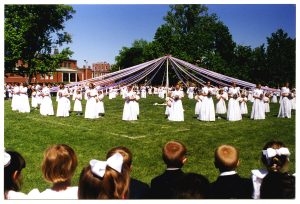 MAYPOLE
MAYPOLE
The Maypole is the traditional dance performed by the Eighth Class girls, accompanied by the Second Class girls. It is performed twice, once after the May Crowning with the entire school in attendance and again after the Graduation ceremony.
FEAST OF ST. MADELEINE SOPHIE BARAT
St. Madeleine Sophie is the foundress of the Society of the Sacred Heart. Her May 25 feast day is often celebrated earlier in spring in order to avoid multiple year-end activities. Mass is celebrated in solemnity and joy.
DISTRIBUTION OF PRIZES
This is a formal assembly on the last day of the school year. Middle School students are recognized for outstanding academic and artistic achievements and character development. Lower School students are recognized for successful completion of the school year. The children express their gratitude to the administration, faculty and staff for the school year.
